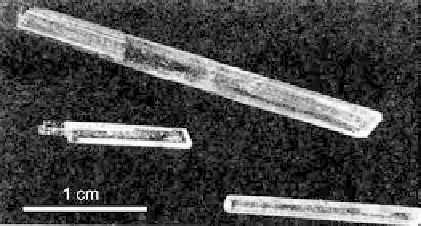Geoscience Reference
In-Depth Information
Figure 8.30 Photograph of Pb
5
S
2
I
6
single crystals
[111]
.
The method of producing arsenic and bismuth sulfohalides differs very little
from that producing the corresponding antimony sulfohalides. Above 200
C, the
arsenic varieties are characterized by the “igneous” melting of the charge as a
result of which a reddish-brown viscous liquid is formed. In experiments at about
300
C, the liquid turns into a vitreous mass on cooling and this is amorphous with
reference to X-rays. The important chalcohalides obtained by the hydrothermal
technique are SbSI, SIAs, and BiSI.
8.12 Hydrothermal Synthesis of Selenides, Tellurides,
Niobates, and Tantalates
Selenides and tellurides are popularly grown by two methods: melt and hydrother-
mal. Although the melt method has been used as the main one for preparing single
crystals of selenides and tellurides, some of these belong to the group of minerals
which have been deposited in nature under hydrothermal conditions. Among the
selenides and tellurides, HgSe, ZnSe, CdSe, HgTe, ZnTe, CdTe, FeTe
2
,FeSe
2
,
NiSe
2
, NiTe
2
, CoSe
2
, CoTe, Sb
2
Se, Bi
2
Se
3
,Bi
2
Te
3
, and Sb
2
Te
3
are the most popu-
lar ones
[98,113
115]
. Their stability range, within a wide interval of pH and Eh
values, allows one to use various solutions for crystallization and to investigate the
influence of physicochemical conditions on the properties of crystals. In fact, sev-
eral solutions have been proposed, and the most commonly used ones are the
alkaline solutions (5 M NaOH, for ZnSe, 1 M NaOH or KOH for ZnTe, and 20 M
NaOH or KOH for CdSe and CdTe).
Polycrystallization HgSe and HgTe or elements in stoichiometric proportions
are used as the starting materials. The temperature of growth is 350
380
C,
P
5
1000
2000 atm
[116]
. Several experiments have been carried out in acid
media (HCl and HBr) in vitreous silica ampoules. Rau and Rabenau
[116]
have
used CO
2
pressure balance gas by pumping CO
2
from a cylinder with a high-
pressure intensifier into the autoclave at room temperature. In seeded growth, the
temperature gradient was usually 25
C.
Figure 8.31
shows the morphology of ZnSe
in NaOH and LiOH solutions. The chemical reactions responsible for the crystalli-
zation of HgSe and HgTe, for example, can be written as follows:


